Exploring the MLA Format– A Complete Guidebook for Students
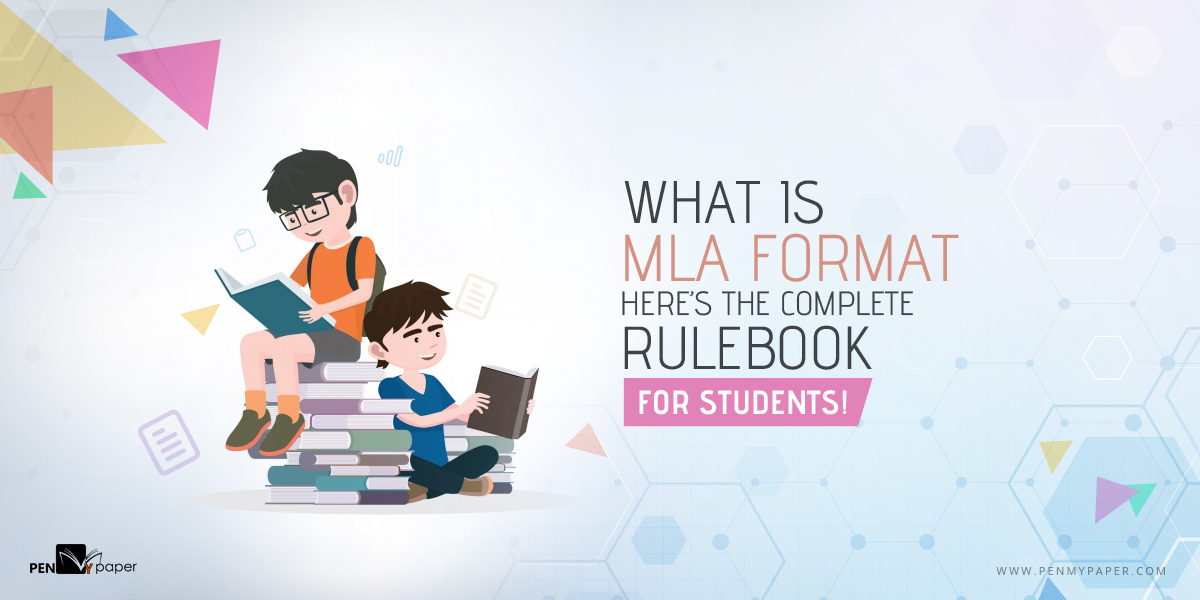
Quick Navigation
When it comes to academic writing, following the appropriate formatting style is essential. One of the most commonly used styles is the Modern Language Association (MLA) format. Whether you are a high school student or pursuing higher education, understanding and applying MLA guidelines can greatly enhance the quality of your papers. In this comprehensive guidebook, our advisors will walk you through the various aspects of MLA format, providing you with the knowledge and tools necessary to excel in your academic writing and help you write my paper effortlessly.
What is MLA Formatting Style?
MLA (Modern Language Association) formatting style is a set of guidelines and conventions for structuring and presenting written documents, particularly in the field of humanities. It provides rules for formatting academic papers, citing sources, and creating bibliographies or works-cited pages. The MLA style is widely used by students, scholars, and researchers in disciplines such as literature, language, cultural studies, and related fields.
The primary purpose of using MLA style is to provide uniformity, clarity, and transparency in academic writing and research. It helps readers easily locate and verify the sources used, ensures proper attribution of ideas and information, and maintains academic integrity and intellectual honesty. Additionally, MLA format promotes consistency and readability, facilitating effective communication and understanding in the field of humanities particularly.
MLA referencing format is widely used because it provides a clear and standardized way to cite sources in academic writing. It helps to maintain academic integrity, give proper credit to the original authors, and allow readers to locate the cited sources for further research.
What is an MLA Format Paper?
An MLA format paper is a written document that follows the guidelines set forth by the Modern Language Association (MLA) for structuring and formatting academic papers. MLA format provides a standardized framework for organizing and presenting written work, including essays, research papers, and other scholarly documents.
MLA format covers various aspects of the paper, including page layout, in-text citations, works-cited page, and overall document presentation. Adhering to MLA guidelines helps ensure consistency, clarity, and credibility in academic writing.
The latest edition of the MLA Handbook is the 9th edition, published in 2021. In the following sections of this article, we have provided an overview of the most up-to-date MLA referencing style guidelines, covering proper source citation and paper formatting.
General Guidelines for MLA Format Paper
To effectively format your paper in MLA style, it is crucial to adhere to the general guidelines provided by the Modern Language Association (MLA). These guidelines ensure consistency and professionalism in academic writing. In this section, we will explore the key general guidelines for an MLA format paper.
Paper Size and Margins:
Ensure that your paper is formatted on standard 8.5 x 11-inch white paper. Set all margins (top, bottom, left, and right) to 1 inch.
Font and Font Size:
Use a legible font throughout your paper, such as Times New Roman. Set the font size to 12 points.
Line Spacing:
Double-space the entire paper, including the title, headings, block quotes, notes, and the Works Cited page. Avoid adding extra spaces between paragraphs or sections.
Alignment and Indentation:
Align the text to the left margin, leaving the right margin ragged (not justified). Indent the first line of each paragraph by 0.5 inches using the “Tab” key or the paragraph formatting options in your word processor.
Title:
In MLA format, a separate title page is typically not required unless specified by your instructor. Instead, place your name, the instructor’s name, the course name or number, and the date in the upper left corner of the first page. Create a title for your paper that is centered, using standard capitalization (not in all capital letters or italics).
Page Numbers:
Include a header on each page, aligning your last name followed by a space and the page number in the upper right corner. Use the “Insert” or “Header” function in your word processor to ensure automatic numbering.
Section Headings:
Use section headings to organize your paper if necessary. Headings should be centered, capitalized (title case), and not in bold or italics. Subheadings can be used for further divisions, aligned to the left, and italicized or placed in bold.
In-Text Citations:
Whenever you use information or ideas from a source, whether it is a direct quote or paraphrased content, you must provide in-text citations. In MLA format, include the author’s last name and the page number of the cited material within parentheses. Place the citation directly after the borrowed information or at the end of the sentence before the punctuation mark.
Works Cited Page:
At the end of your paper, include a separate page titled “Works Cited” that lists all the sources you have cited in your paper. The entries should be organized alphabetically by the author’s last name or the title of the source if no author is specified. Use hanging indentation for each entry, where the first line is flush left, and subsequent lines are indented.
To enhance your understanding of MLA format, it would be advantageous to explore an APA format example as well. This will provide you with insights into the guidelines and requirements of APA style, expanding your knowledge and enabling you to navigate both citation formats effectively.
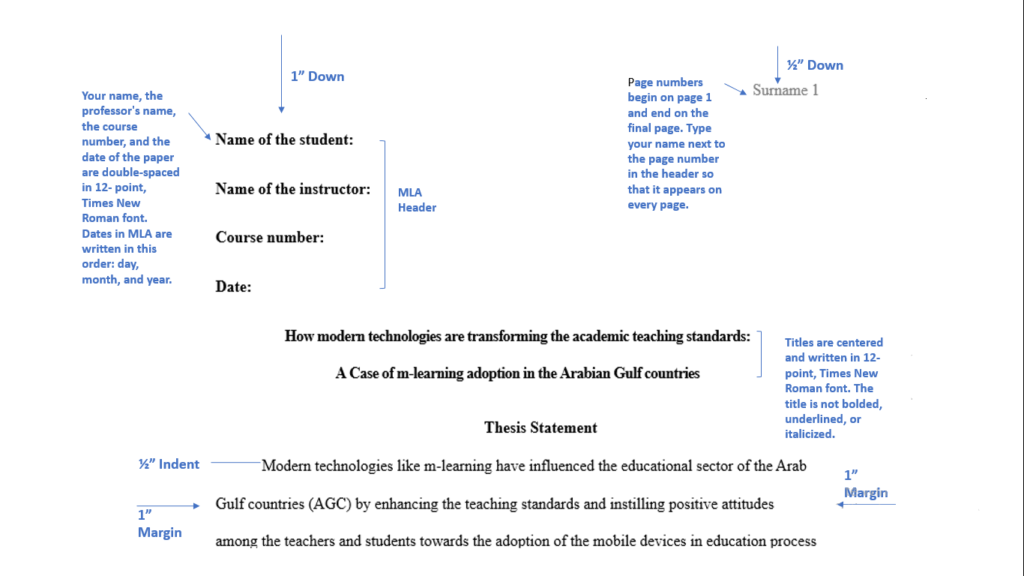
Header and Title Formatting in MLA
MLA format papers differ from other referencing styles in that they do not require a title page. Instead, the first page of the paper includes the heading and the title, followed by the body of the paper. The construction of the first page is as follows:
Header:
Begin by leaving one inch of space from the top of the page and type the following information flush with the left margin:
Your Full Name
Name of your Instructor
Course Name and Number
Due Date of the Assignment
Title:
The title should be centered on the next line. If you need to reference another work or title within your title, you can use quotation marks or italics. For example: ” The Influence of Climate Change on Marine Ecosystems.”
After the title, indent the subsequent line and start typing your text. To create a page header, write your last name and insert the page numbers in the top margin, flush-right, on each page. The page numbers should be placed one-half inch from the top and aligned with the right margin.
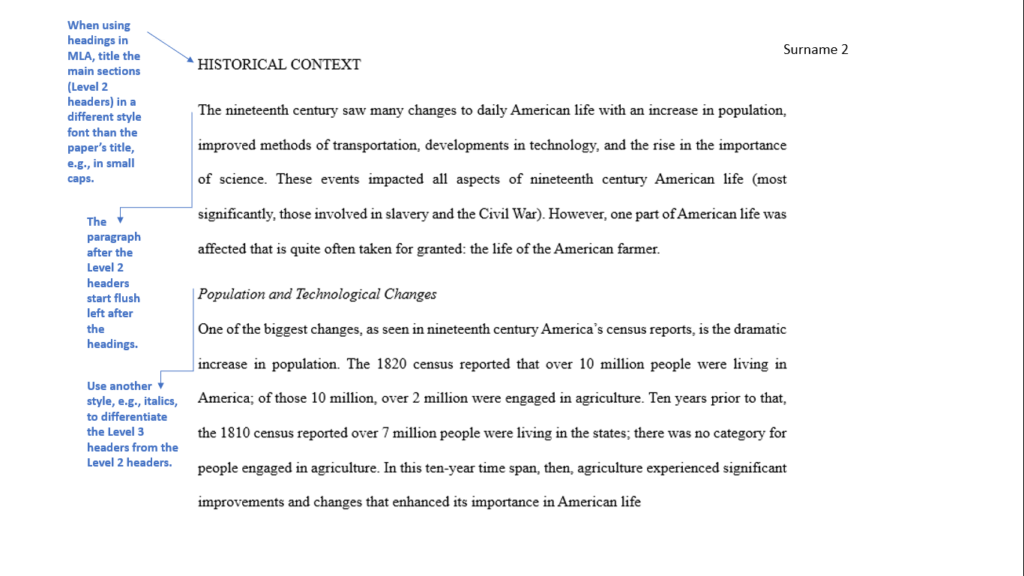
MLA Referencing Format
There are two types of MLA format citation styles: Parenthetical or In-text Citations and Works Cited.
Parenthetical or In-text Citations:
In MLA format, parenthetical citations are used to acknowledge the sources directly within the text of the paper. These citations typically include the author’s last name and the page number(s) from which the information is taken. The purpose of these citations is to direct readers to the full citation on the Works Cited page.
For example:
When directly quoting a source: “This is a direct quote” (Smith 45).
When paraphrasing or summarizing a source: (Smith 45).
When the author’s name is mentioned in the text: According to Smith, “…” (45).
Works Cited:
The Works Cited page is a separate page at the end of the paper that lists all the sources cited in the text. It serves as an organized compilation of the sources you have paraphrased or quoted in your paper. It is arranged in alphabetical order and corresponds to the parenthetical citations used within the text. Each entry on the Works Cited page provides detailed information about the source, allowing readers to locate and access the original work.
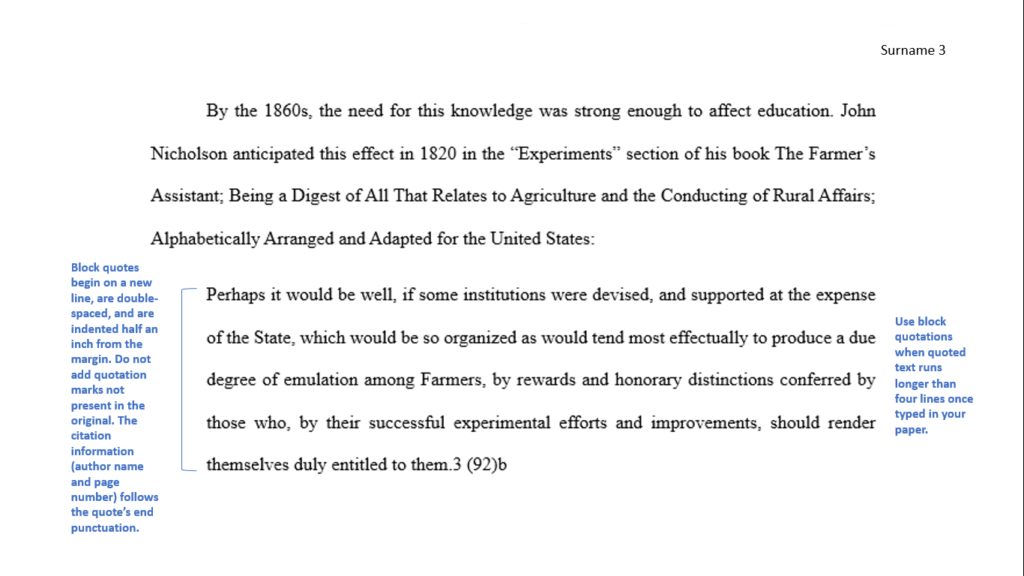
The Works Cited page should adhere to the following guidelines:
- Placement and numbering:
It should be positioned at the end of your paper and follow the consecutive numbering of the rest of your document.
- Heading:
The page should feature the centered heading “Works Cited” at the top.
- Inclusion of sources:
All the sources that you have paraphrased or quoted in your paper should be listed on this page.
- Alphabetical order:
The sources should be alphabetized based on the author’s last name. If no author is present, the entries can be organized by title.
- Hanging indents:
The formatting of the entries should include hanging indents, meaning that the lines following the first line of each entry are indented.
The general format for an entry on the Works Cited page includes the following elements:
Author’s name(s).
Title of the source (book, article, website, etc.).
Title of the container (if applicable, such as a book within an anthology),
Other contributors (editors, translators, etc.),
Version (if applicable),
Number (if applicable),
Publisher,
Publication date,
Location (such as page numbers or URL).
MLA format citation provides specific guidelines for formatting each type of source, such as books, journal articles, websites, and more. It is important to follow these guidelines carefully to ensure accuracy and consistency.
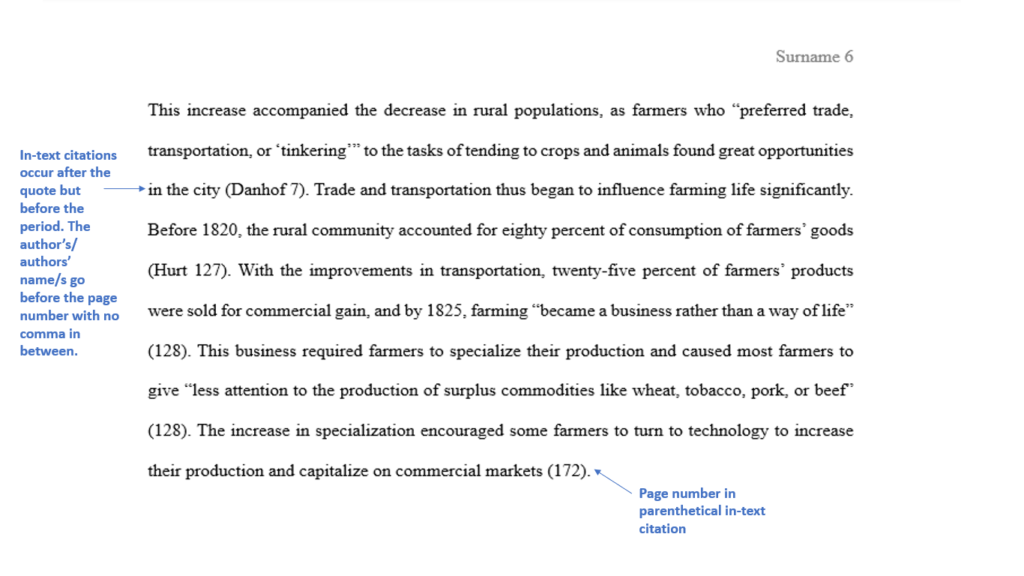
Referencing Different Sources Using MLA Format
In MLA format, different types of sources require specific formatting to provide accurate and consistent citations. Below we have provided the referencing formats for various common sources used in academic writing.
Books:
- Book by a single writer:
Works Cited: Brinkley, Alan. The Unfinished Nation: A Concise History of the American People. 7th ed., McGraw Hill, 2014, p. 525.
In-text citation: (Brinkley 525)
- Book by two writers:
Works Cited: Wilson, Charles, and Eric Schlosser. Chew on This: Everything You Don’t Want to Know about Fast Food. Houghton Mifflin, 2007.
In-text citation: (Wilson and Schlosser 67)
- Book by three or more writers:
Works Cited: James, Charles, et al. The Sociological History of People and Places. Magnolia Press, 2005.
In-text citation: (James et al. 157-165)
Websites:
Works Cited: Johnson, Sarah. “MLA Website Citation Guidelines.” Online Bibliography, 2022, www.onlinebibliography.com/mla-website-citation.
In-text citation: (Johnson)
Journal Article in a Database with a DOI:
Works Cited: Anderson, Emily. “The Impact of Climate Change on Biodiversity.” Environmental Studies Journal, vol. 15, no. 2, 2019, pp. 25-40. doi:10.1234/esj.15.2.28
In-text citation: (Anderson 28)
Newspapers:
Works Cited: Robinson, Mark. “New Discoveries in Space Exploration.” The Daily Times, 20 Nov. 2021, pp. A5-A6.
In-text citation: (Robinson A5)
Remember to consult the MLA Handbook or reputable online resources for specific instructions on formatting citations for less common sources, such as government documents, conference proceedings, or artwork.
Also read: How to successfully develop a thesis statement for a research paper.
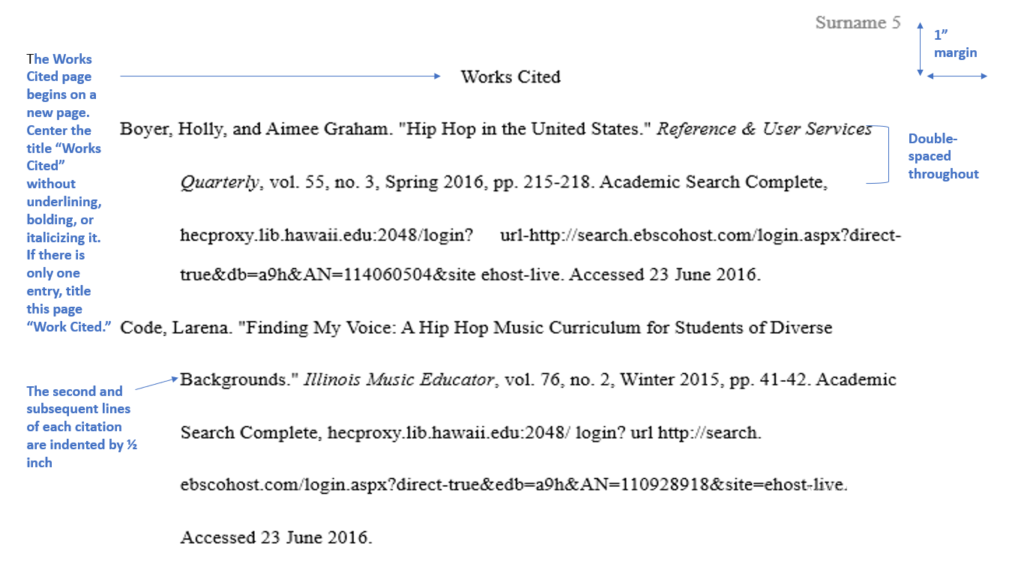
Style and Language in MLA Format
Consistency in Writing Style:
Consistency in writing style is a fundamental aspect of MLA format. To maintain coherence and professionalism in your paper, it is crucial to adhere to a consistent writing style throughout. This includes consistent use of verb tense, sentence structure, and tone. Avoid shifting between formal and informal language, and strive for a consistent and scholarly tone in your writing.
Punctuation and Capitalization:
In MLA format, it is important to follow specific rules regarding punctuation marks and capitalization. Use standard punctuation marks such as commas, periods, and colons appropriately. Capitalize the first letter of each major word in titles and headings, while using lowercase for articles, prepositions, and conjunctions, unless they appear as the first or last word in a title.
Abbreviations and Acronyms:
When using MLA format, it is advisable to spell out terms fully upon their first mention, followed by their abbreviated form in parentheses. Afterward, the abbreviated form can be used consistently throughout the paper. However, ensure that the use of abbreviations does not compromise the clarity or readability of your text.
Using Italics and Quotation Marks:
Italics and quotation marks serve distinct purposes in MLA format when it comes to citing and emphasizing different types of sources. Italicize titles of longer works, such as books, journals, and films, while using quotation marks for shorter works like articles, poems, and song titles. Additionally, use quotation marks when directly citing someone’s words or when referring to specific terms or concepts. By correctly using italics and quotation marks, you provide visual cues that help readers navigate your citations and understand your intended emphasis.
Working with Non-English Sources:
In scholarly research, it is not uncommon to encounter non-English sources, such as foreign-language books, articles, or interviews. When referencing non-English sources, provide the original title in its original language, followed by an English translation in square brackets. This allows readers to understand the source’s title while maintaining the integrity of the original work. If quoting directly from a non-English source, provide an English translation within the text or as a footnote to ensure comprehension for readers who may not be familiar with the language.
Conclusion
Mastering the MLA format is a valuable skill that will not only help you achieve higher grades but also prepare you for future academic and professional endeavors. By following the guidelines outlined in this guidebook, you can ensure that your papers are well-structured, properly documented, and adhere to the standards set by the Modern Language Association. Correctly implemented in-text citations and a well-constructed Works Cited page showcase one’s intellectual integrity, while adherence to prescribed style and language conventions enhances the overall presentation of scholarly work.
MLA isn’t merely a set of rules but a means of elevating the quality and credibility of academic writing. Hopefully, this guidebook will help you format your paper according to MLA style effortlessly. In case you still find it difficult, know that you have the option to pay for essays written so that you don’t have to worry about writing the paper as we can help deliver an immaculate paper, written from scratch and accurately formatted according to the prescribed format.

